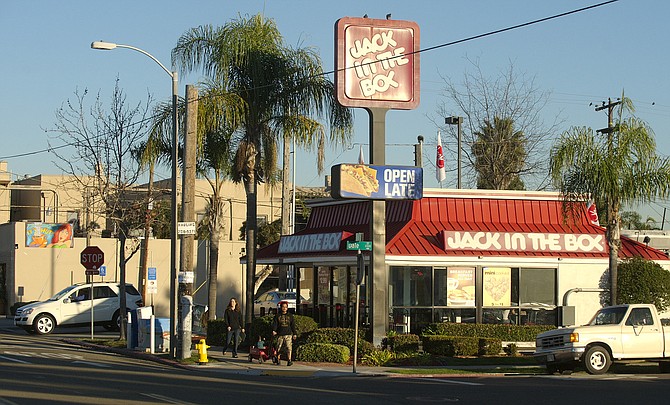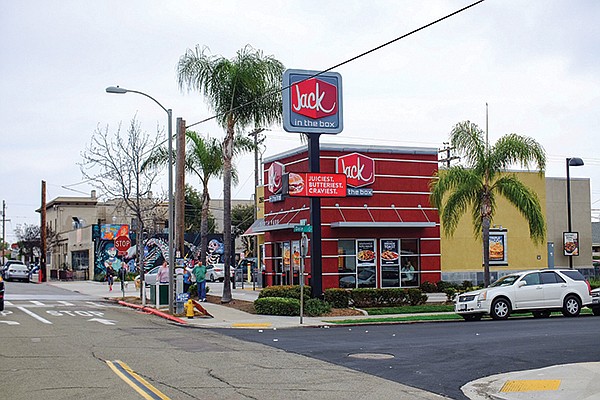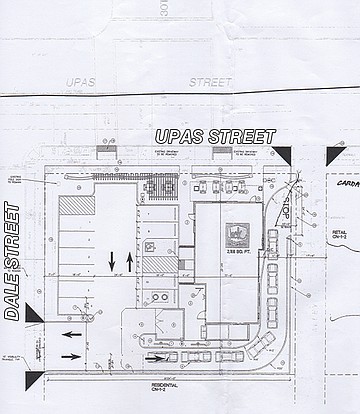 Facebook
Facebook
 X
X
 Instagram
Instagram
 TikTok
TikTok
 Youtube
Youtube

The solution seemed simple: city staff show judge Gregory Pollack a copy of the original building permit it issued to fast-food chain Jack in the Box for an overhaul of a North Park restaurant, and the four-year-long court case would vanish. The Jack in the Box drive-thru at 2959 Upas Street would remain in operation, attorneys for the city would no longer need to dedicate time and city resources — on top of the hundreds of hours already spent — and litigious neighbors could go about their lives knowing that the rules were followed.

But four years after a group of North Park residents sued the city and Jack in the Box for what they claim was an end-run around city zoning laws, the likelihood a permit will be produced is remote. Conversely, a May 2016 decision by a California appellate court to send the case back to superior court for a trial means the likelihood of a protracted legal battle is high.

In 2012, the Reader reported on Jack in the Box’s proposal to remodel a 1960s-era drive-thru restaurant located at the busy intersection of Upas and 30th streets in North Park, seven blocks from Morley Field. But the company ran into obstacles from residents and new zoning laws.
The intersection is at the boundary of North Park’s bustling business district and high-priced residential homes. (Within a five-block radius, recent home prices ranged from $649,000 for a condo to $840,000 for a 1400-square-foot, three-bedroom; a four-bedroom, 2700-square-foot house was listed for $1.29 million.)
Residents hoped to see a balance between commericial and residential interests when the city adopted new zoning regulations in 2000. Those regulations prohibited certain commercial uses, including drive-thru restaurants. The Jack in the Box, however, was exempt from the rules. It had been built before the new regulations were adopted.
Still, the regulations posed problems for Jack in the Box executives. The restaurant, over 50 years old, needed an update. But in order to keep the drive-thru, executives and architects had to abide by city laws. Among them were prohibitions against demolishing any exterior walls, increasing the footprint of the building, or undertaking any renovation that cost greater than 50 percent of the existing restaurant’s value. But that didn’t prevent Jack in the Box from proposing to demolish the old restaurant and build a slightly larger one in its place. In January 2011, the North Park Planning Group rejected the plan. San Diego planning commissioners followed suit, ultimately killing the proposal.
The company wouldn’t be boxed in by city regulations. In 2013, Jack in the Box applied for a renovation permit, a ministerial permit obtained at the city’s Development Services Department counter, allowing executives to forego obtaining the planning commission’s approval. Residents worried city staff would capitulate to Jack in the Box executives.
On May 2, 2013, city staff issued a building permit to allow for a remodel of the current structure.
In an effort to assuage residents’ fears, Jack in the Box construction manager Mike Hogenboom penned a letter to then–North Park planning chair Vicki Granowitz, assuring the group that the company would abide by the rules.
“We are not demolishing any of the exterior walls,” Hogenboom wrote in the letter to Granowitz.
During the following weeks, crews leveled the restaurant. No walls were left standing. Residents contacted then–mayor Bob Filner to complain about the violations and the broken promises. On July 3, 2013, then–interim director of the Development Services Department Tom Tomlinson wrote to the city attorney’s office seeking guidance on whether the city could put a stop to the project.
“The applicant is currently out of compliance with the issued permit due to the partial demolition of two walls that were not identified on the approved plans,” Tomlinson wrote. “Note that many members of the community have strongly voiced their opposition to the project. The applicant has shown a flagrant disregard for the welfare of the community and the integrity of the permitting process.”
But promises from Filner’s office were as empty as those from Jack in the Box’s construction manager. Left on their own, residents filed a lawsuit against Jack in the Box and the city in August 2013. In their complaint, the attorney for the residents, Cory Briggs, argued that the city had amended the May 2 permit in July 2013 to allow for “extensive demolition of interior and exterior walls and roof structure….”
The complaint, however, was submitted 102 days after staff had issued the May 2 permit, 12 days after the 90-day statute of limitations in challenging building decisions had expired. The city argued the statute of limitations invalidated the lawsuit. San Diego Superior Court judge Ronald Prager agreed. Residents then filed an appeal to the court’s ruling, stating that misrepresentations made by Jack in the Box — as well as promises from San Diego’s mayor — prevented them from filing sooner. The appellate court sided with the residents, remitting the case back to superior court for a trial.
From May 2016 to January 2017, attorney Briggs has asked for copies of the original permit. The city and Jack in the Box, however, have ignored his requests and provided only the expanded version.
In the coming months, however, city staff and Jack in the Box executives will be forced to testify and explain why — if the original permit called for “extensive demolition” — the director of Development Services wrote a letter stating the company was not in compliance with the permit.
“It strains credulity to think that nobody at the city, nobody at Jack in the Box headquarters, and nobody on Jack in the Box’s construction team has a copy of the permit anywhere. Jack in the Box’s construction manager stated in writing that there would be no exterior demolition. So there’s only one reason why the city and Jack in the Box would be fighting so hard to prevent knowledgeable officials from being ordered by the judge to produce a true and complete copy of the permit, instead of substitutes, under penalty of perjury: the permit conflicts with the lies the city and Jack in the Box have been telling the judge.”
Spokesperson for the city attorney’s office, Gerry Braun, did not respond to a request for comment as to whether the city has turned over the original permit. Media relations staff for Jack in the Box also did not respond.


The solution seemed simple: city staff show judge Gregory Pollack a copy of the original building permit it issued to fast-food chain Jack in the Box for an overhaul of a North Park restaurant, and the four-year-long court case would vanish. The Jack in the Box drive-thru at 2959 Upas Street would remain in operation, attorneys for the city would no longer need to dedicate time and city resources — on top of the hundreds of hours already spent — and litigious neighbors could go about their lives knowing that the rules were followed.

But four years after a group of North Park residents sued the city and Jack in the Box for what they claim was an end-run around city zoning laws, the likelihood a permit will be produced is remote. Conversely, a May 2016 decision by a California appellate court to send the case back to superior court for a trial means the likelihood of a protracted legal battle is high.

In 2012, the Reader reported on Jack in the Box’s proposal to remodel a 1960s-era drive-thru restaurant located at the busy intersection of Upas and 30th streets in North Park, seven blocks from Morley Field. But the company ran into obstacles from residents and new zoning laws.
The intersection is at the boundary of North Park’s bustling business district and high-priced residential homes. (Within a five-block radius, recent home prices ranged from $649,000 for a condo to $840,000 for a 1400-square-foot, three-bedroom; a four-bedroom, 2700-square-foot house was listed for $1.29 million.)
Residents hoped to see a balance between commericial and residential interests when the city adopted new zoning regulations in 2000. Those regulations prohibited certain commercial uses, including drive-thru restaurants. The Jack in the Box, however, was exempt from the rules. It had been built before the new regulations were adopted.
Still, the regulations posed problems for Jack in the Box executives. The restaurant, over 50 years old, needed an update. But in order to keep the drive-thru, executives and architects had to abide by city laws. Among them were prohibitions against demolishing any exterior walls, increasing the footprint of the building, or undertaking any renovation that cost greater than 50 percent of the existing restaurant’s value. But that didn’t prevent Jack in the Box from proposing to demolish the old restaurant and build a slightly larger one in its place. In January 2011, the North Park Planning Group rejected the plan. San Diego planning commissioners followed suit, ultimately killing the proposal.
The company wouldn’t be boxed in by city regulations. In 2013, Jack in the Box applied for a renovation permit, a ministerial permit obtained at the city’s Development Services Department counter, allowing executives to forego obtaining the planning commission’s approval. Residents worried city staff would capitulate to Jack in the Box executives.
On May 2, 2013, city staff issued a building permit to allow for a remodel of the current structure.
In an effort to assuage residents’ fears, Jack in the Box construction manager Mike Hogenboom penned a letter to then–North Park planning chair Vicki Granowitz, assuring the group that the company would abide by the rules.
“We are not demolishing any of the exterior walls,” Hogenboom wrote in the letter to Granowitz.
During the following weeks, crews leveled the restaurant. No walls were left standing. Residents contacted then–mayor Bob Filner to complain about the violations and the broken promises. On July 3, 2013, then–interim director of the Development Services Department Tom Tomlinson wrote to the city attorney’s office seeking guidance on whether the city could put a stop to the project.
“The applicant is currently out of compliance with the issued permit due to the partial demolition of two walls that were not identified on the approved plans,” Tomlinson wrote. “Note that many members of the community have strongly voiced their opposition to the project. The applicant has shown a flagrant disregard for the welfare of the community and the integrity of the permitting process.”
But promises from Filner’s office were as empty as those from Jack in the Box’s construction manager. Left on their own, residents filed a lawsuit against Jack in the Box and the city in August 2013. In their complaint, the attorney for the residents, Cory Briggs, argued that the city had amended the May 2 permit in July 2013 to allow for “extensive demolition of interior and exterior walls and roof structure….”
The complaint, however, was submitted 102 days after staff had issued the May 2 permit, 12 days after the 90-day statute of limitations in challenging building decisions had expired. The city argued the statute of limitations invalidated the lawsuit. San Diego Superior Court judge Ronald Prager agreed. Residents then filed an appeal to the court’s ruling, stating that misrepresentations made by Jack in the Box — as well as promises from San Diego’s mayor — prevented them from filing sooner. The appellate court sided with the residents, remitting the case back to superior court for a trial.
From May 2016 to January 2017, attorney Briggs has asked for copies of the original permit. The city and Jack in the Box, however, have ignored his requests and provided only the expanded version.
In the coming months, however, city staff and Jack in the Box executives will be forced to testify and explain why — if the original permit called for “extensive demolition” — the director of Development Services wrote a letter stating the company was not in compliance with the permit.
“It strains credulity to think that nobody at the city, nobody at Jack in the Box headquarters, and nobody on Jack in the Box’s construction team has a copy of the permit anywhere. Jack in the Box’s construction manager stated in writing that there would be no exterior demolition. So there’s only one reason why the city and Jack in the Box would be fighting so hard to prevent knowledgeable officials from being ordered by the judge to produce a true and complete copy of the permit, instead of substitutes, under penalty of perjury: the permit conflicts with the lies the city and Jack in the Box have been telling the judge.”
Spokesperson for the city attorney’s office, Gerry Braun, did not respond to a request for comment as to whether the city has turned over the original permit. Media relations staff for Jack in the Box also did not respond.
Comments